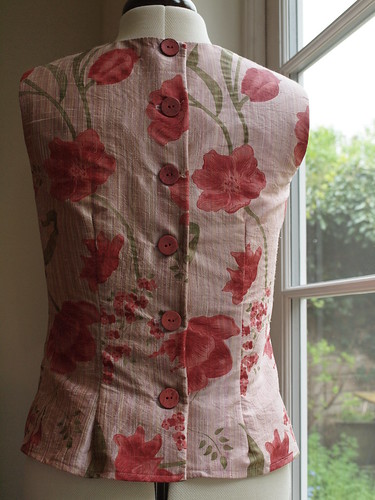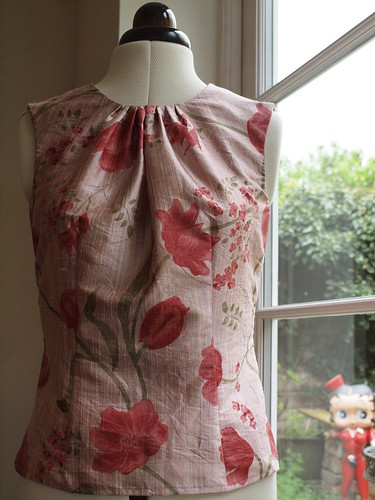

Gosh, I have been so busy with sewing and other things that I haven't found the time to make a blog post.
Since my last post I have made two garments, with another half finished. One of the things I completed was a pair of Iris shorts from Colette Patterns, which I made in navy drill, with Liberty lawn pockets, polka dot facings and Liberty faced hems.
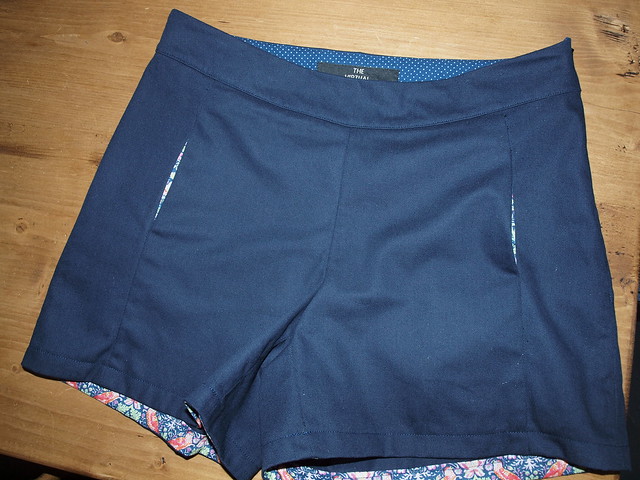
Colette patterns are drafted with a pear-shaped figure in mind and, having found the Beignet skirt pattern so wide on my hips, I wasn't sure whether I should bother even trying to make up my first proper pair of shorts/trousers from a pattern I knew would need a lot of alterations to make fit.
I was still on the fence when I had an "aha" moment. I was doing the Susan Khalje Craftsy course, The Couture Dress, and she has you make up a muslin first, but using the stitching lines as your point of reference instead of the cutting lines most of us are used to, and working with a generous seam allowance. I thought I would fit my muslin and then take it apart and use the muslin itself as the pattern pieces, just as she does.
I roughly cut out my paper pattern pieces. Then I decided which size was my starting point. Because it was trousers I went with the hip measurement, which was a size 2 (in this case, a bad move). Have I mentioned that I am NOT pear-shaped? There are only six inches difference between my waist and hip, and I think Colette Patterns have a ten inch difference. With Sewaholic it's a twelve-inch difference. You can imagine how HUGE everything is on my hips (or how small on the waist!) Anyhow, since I chose my size for the shorts by hip measurement it meant I would have to hugely alter the waist size on this muslin. However, it wasn't as simple as that, as it turned out everything was wrong for me, including the crotch depth. But it was surpisingly "possible" to get them to fit in the end because of the way I did it. But I haven't explained yet.
As I said, I roughly cut out my pattern pieces. I marked the stitching lines for the size I chose, 1.5cm in from
what would usually be the cutting line.

I pinned the pattern pieces to the muslin fabric and traced the stitching lines, notches etc. onto the muslin. Then I stitched along the stitching lines to make a permanent reference that wouldn't rub off, and it would stop the fabric stretching out, too.

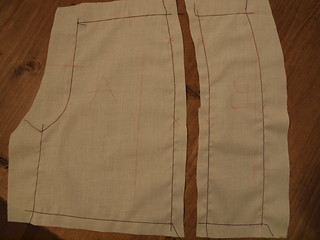
I then stitched the pieces together along the stitching lines and when I tried on the shorts I realised that the whole fit was so wrong on me. I mean, everything. I won't go into details because it would bore the pants off you, but I took the muslin apart, remarked the stitching lines as a size 6 (nearer my waist size) and took in the hips a bit here and there, and tweaked various other bits, like the crotch depth etc. What I ended up with was totally personalised pattern which was nowhere near any of the standard sizes. But instead of having to somehow transfer that to my paper pattern, which would have been too complicated for me to bother, all I had to do was take my muslin apart (having marked all the revised stitching lines carefully) and use it to cut out my main fabric. You can see my revised stitching lines marked in green (click the photos for larger sizes).
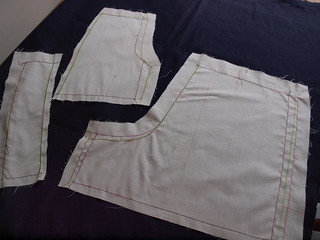
It worked really well and I am so happy with the result. I am planning to make the Iris shorts again in red drill, and all I will have to do is use my muslin pieces, which are all nicely folded inside my pattern wallet. How cool is that? I really don't think I could have fitted these shorts if I had just cut out one size, with a 1.5 seam allowance, instead of about a 3cm allowance, in the usual way. I would have ended up binning the whole attempt. I tried the Clover trousers a few months ago and just couldn't get them to fit, having cut out a size 4. Again, it was all wrong. Next time I will cut a size 6 with huge seam allowances and tweak and tweak until they are right, and then use my muslin as the pattern again. I think I can do it. It's a time consuming process, though not too bad for a pair of shorts, and I will only use it for items that require a lot of fitting.
